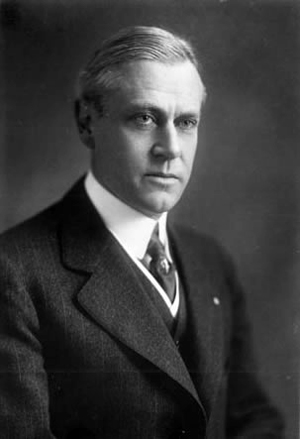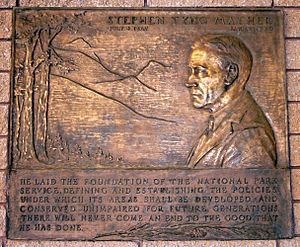Stephen Mather facts for kids
Quick facts for kids
Stephen Mather
|
|
|---|---|
 |
|
| 1st Director of the National Park Service | |
| In office May 16, 1917 – January 8, 1929 |
|
| President | Woodrow Wilson Warren Harding Calvin Coolidge |
| Preceded by | Office established |
| Succeeded by | Horace M. Albright |
| Personal details | |
| Born | July 4, 1867 San Francisco, California |
| Died | January 22, 1930 (aged 62) Brookline, Massachusetts |
| Resting place | Mather Cemetery, Darien, Connecticut |
| Spouse | Jane T. Floy (1893) |
| Children | Bertha Floy Mather |
| Alma mater | University of California, Berkeley |
| Occupation | Businessman Naturalist |
| Awards | Public Welfare Medal (1930) |
Stephen Tyng Mather (July 4, 1867 – January 22, 1930) was an American businessman and conservationist. He is famous for being the very first director of the National Park Service.
Mather became a millionaire through his borax company. He loved nature and wanted to protect America's beautiful places. With his friend, journalist Robert Sterling Yard, he worked hard to create a special government group to manage the National Parks. This group, the National Park Service (NPS), was started in 1916.
In 1917, Stephen Mather was chosen to lead the new NPS. He served until 1929. During his time, he made the NPS a strong organization. He also helped create many new national parks and monuments. He set up clear rules for adding new places to the park system.
Contents
Early Life and Work
Stephen Tyng Mather was born on July 4, 1867, in San Francisco, California. His parents were Joseph W. Mather and Bertha Jemima Walker. He went to Boys' High School in San Francisco. Later, he graduated from the University of California, Berkeley in 1887.
After college, Mather's family moved to New York. He worked as a reporter for the New York Sun newspaper until 1893. There, he met Robert Sterling Yard, who became a close friend. In 1893, Mather married Jane Thacker Floy. They had one daughter, Bertha Floy Mather.
In 1906, Mather became the owner of his family's old home in Connecticut. It was built around 1778. He and his family spent their summers there. He thought of it as his true home.
Business Success
Mather started working for the Pacific Coast Borax Company in New York. His father was an administrator there. Borax is a mineral used in many cleaning products. It was mostly mined in California.
In 1894, Mather moved to Chicago with his wife. He set up a distribution center for the company. He was very good at advertising and selling products. He is known for the idea of putting the "20 Mule Team Borax" label on the company's products. This label became very famous across the country.
In 1898, Mather helped his friend Thomas Thorkildsen start another borax company. Mather joined Thorkildsen full-time in 1904. Their company, the Thorkildsen-Mather Borax Company, became very successful. By 1914, Mather was a millionaire. This money allowed him to focus on his personal interests. He retired from the company in his mid-forties.
Protecting Nature
In 1904, Mather traveled to Europe with his wife. He saw Europe's parks and how people could easily visit them. This trip made him want to protect more natural areas in the U.S. He wanted to make them easy for everyone to enjoy. He became a strong conservationist. He was also a friend and admirer of the famous naturalist John Muir.
In 1904, Mather joined the Sierra Club, a group that works to protect the environment. He climbed Mount Rainier with some members the next year. He made many friends in the group who helped him create the National Park Service. In 1916, the Sierra Club made him an honorary vice-president.
In 1915, Mather also joined the Boone and Crockett Club. This conservation group was started by Theodore Roosevelt in 1887.
Becoming Park Director
There's a well-known story about how Mather came to Washington to run the National Parks. In this story, Mather wrote a letter to the Secretary of the Interior, Franklin K. Lane, complaining about the parks. Lane supposedly replied, "Dear Steve, If you don't like the way the parks are being run, come on down to Washington and run them yourself."
However, Mather's assistant, Horace Albright, later said this story wasn't quite true. Mather and Lane didn't know each other before 1914.
Mather did go to Washington to work as an assistant to the Secretary of the Interior. He worked hard to get a special government office created to manage the national parks. On August 25, 1916, President Woodrow Wilson signed the law that created the National Park Service.
At that time, the government had 14 parks and 19 national monuments. Many were managed by army officers. Mather used his own money to hire Robert Sterling Yard. Yard helped him tell people about the amazing beauty of the parks. Mather was very good at getting support for the parks from politicians and wealthy business leaders. He wanted more people to visit and appreciate the parks.
In April 1917, Mather became the first director of the National Park Service. He held this job until he had to resign in January 1929 due to illness. He and his team made the NPS one of the most respected parts of the government. Horace M. Albright, another Sierra Club member, was Mather's assistant. Albright often served as acting director when Mather faced health challenges.
The National Park Service Under Mather
When the National Park Service was created in 1916, Mather agreed to stay on. With Albright, he helped build the new federal agency. Its job was to protect and manage the national parks. They also helped people appreciate the parks' wonders.
Mather made park management more professional. He created a team of career government workers. These specialists helped operate and manage the parks. They also worked to preserve the parks' natural beauty.
Mather believed that amazing scenery should be the main reason for creating a national park. He worked to establish new parks before their lands could be used for other things.
He also brought concessions to the national parks. These businesses provided visitors with basic services and things they needed. They also offered tools for studying nature. Mather promoted the creation of the National Park to Park Highway. He also encouraged railroads to help more people visit the parks. He thought that if more people visited and had a comfortable stay, they would support the new agency.
By the time Mather left his job, the park system had grown. It included 20 national parks and 32 national monuments. Mather also created the rules for choosing and adding new parks and monuments.
Mather faced health challenges that sometimes kept him from work. Albright continued their shared mission during these times. Together, they convinced Congress to create national parks in the eastern U.S. In 1926, Shenandoah and Great Smoky Mountains national parks were approved. In January 1929, Mather had a stroke and had to leave office. He passed away a year later.
Legacy and Memorials

Stephen Mather left a lasting impact on America's national parks.
- In 1928, he received the first Cornelius Amory Pugsley Gold Medal Award.
- In 1930, after he died, he was given the Public Welfare Medal. This award came from the National Academy of Sciences.
- In 1932, his family and friends created the Stephen Mather Memorial Fund. This fund placed many bronze plaques in national parks. These plaques honor Mather's achievements.
- In 1963, the Stephen Tyng Mather Home in Connecticut became a National Historic Landmark.
- Many places in the National Park System are named after Mather, including:
- Mather Point at Grand Canyon National Park;
- Mather District and Camp Mather in Yosemite National Park;
- Mather Pass in Kings Canyon National Park;
- Mather Gorge near Great Falls Park;
- Mount Mather in Denali National Park;
- Stephen T. Mather Training Center in Harpers Ferry National Historical Park.
- Other places named in his honor include:
- Stephen Tyng Mather High School in Chicago, Illinois;
- Stephen T. Mather Building Arts & Craftsmanship High School in New York City, NY;
- Stephen Mather Memorial Parkway (Washington State Route 410) near Mount Rainier National Park;
- Stephen Mather Wilderness in North Cascades National Park;
- Mather Lodge in Petit Jean State Park, Arkansas.
Images for kids
See also
 In Spanish: Stephen Mather para niños
In Spanish: Stephen Mather para niños


